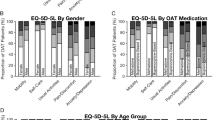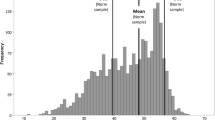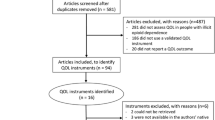Abstract
Background
Few studies have described improvement in health-related quality of life (HRQOL) associated with opioid dependence treatment with buprenorphine (ODT-B).
Objective
To evaluate HRQOL changes in domain scores, physical and mental component summaries, and health utilities (HUs) associated with ODT-B using the Short Form 36 (SF-36).
Methods
We assessed HRQOL changes in a substudy of a pharmacokinetic study that compared buprenorphine oral tablet and liquid dosage formulations over 16 weeks. Individuals, aged 18–65 years, were screened for opioid dependence. They were excluded if they would not agree to birth control or had a serious medical condition. Subjects received psychosocial counseling and weekly group therapy. The SF-36 was administered upon enrollment and at 4-week intervals. We used the SF-6D to estimate HUs. We performed intention to treat (ITT) analyses based on the last observation available for each subject. Paired t tests of each domain and HU, limited to remaining patients at each 4-week interval, were also conducted.
Results
Of 96 subjects enrolled, cumulative dropouts over time resulted in 80, 69, 59, and 44 subjects remaining at 4, 8, 12, and 16 weeks. There were no significant differences in opioid-positive urines, dropout rates, or dosage changes between formulations. In the ITT analyses, HRQOL improvements over time were bodily pain (62.1 vs. 69.1, P = 0.017), vitality (49.8 vs. 56.5, P = 0.001), mental health (59.9 vs. 66.0, P = 0.001), social function (66.4 vs. 74.7, P = 0.001), role emotional (59.4 vs. 71.9, P = 0.003), role physical (60.9 vs. 70.6, P = 0.005), and mental component summary (41.9 vs. 45.4, P<0.001). HU scores also improved (0.674 vs. 0.715, P = 0.001). Results from paired t tests, with only concurrently enrolled patients, showed similar improvements from baseline to 4, 8, 12, or 16 weeks.
Conclusion
Buprenorphine, accompanied with psychosocial counseling, was associated with improved HRQOL and HUs.
Similar content being viewed by others
References
Ling, W., & Wesson, D. R. (2003). Clinical efficacy of buprenorphine comparisons to methadone and placebo. Drug and Alcohol Dependence, 70(2), S49–S57.
Fudala, P. J., Bridge, T. P., Herbert, S., et al. (2003). Office-based treatment of opiate addiction with a sublingual-tablet formulation of buprenorphine and naloxone. New England Journal of Medicine, 349(10), 949–958.
Clark, H. W. (2001). A new era in opioid dependency treatment. Recent law allows qualified physicians to provide care in office setting. Postgrad Med, 109(6), 15–16, 25.
Raisch, D. W., Fye, C. L., Boardman, K. D., & Sather, M. R. (2002). Opioid dependence treatment, including buprenorphine/naloxone. Annals of Pharmacotherapy, 36, 312–321.
Connock, M., Juarez-Garcia, A., Jowett, S., et al. (2007). Methadone and buprenorphine for the management of opioid dependence: a systematic review and economic evaluation. Health Technology Assessment, 11(9), 1–190.
Donaher, P. A., & Welsh, C. (2006). Managing opioid addiction with buprenorphine. American Family Physician, 73(9), 1573–1578.
Ling, W., & Smith, D. (2002). Buprenorphine: blending practice and research. J Subst Abuse Treat, 23(2), 87–92.
Torrington, M., Domier, C. P., Hillhouse, M., & Ling, W. (2007). Buprenorphine 101: treating opioid dependence with buprenorphine in an office-based setting. Journal of Addictive Diseases, 26(3), 93–99.
Bell, J., Shanahan, M., Mutch, C., et al. (2007). A randomized trial of effectiveness and cost-effectiveness of observed versus unobserved administration of buprenorphine-naloxone for heroin dependence. Addiction, 102(12), 1899–1907.
Barnett, P. G., Rodgers, J. H., & Bloch, D. A. (2001). A meta-analysis comparing buprenorphine to methadone for treatment of opiate dependence. Addiction, 96(5), 683–690.
Harris, A. H., Gospodarevskaya, E., & Ritter, A. J. (2005). A randomised trial of the cost effectiveness of buprenorphine as an alternative to methadone maintenance treatment for heroin dependence in a primary care setting. Pharmacoeconomics, 23(1), 77–91.
Doran, C. M., Shanahan, M., Mattick, R. P., Ali, R., White, J., & Bell, J. (2003). Buprenorphine versus methadone maintenance a cost-effectiveness analysis. Drug and Alcohol Dependence, 71(3), 295–302.
Giacomuzzi, S. M., Riemer, Y., Ertl, M., et al. (2003). Buprenorphine versus methadone maintenance treatment in an ambulant setting a health-related quality of life assessment. Addiction, 98(5), 693–702.
Maremmani, I., Pani, P. P., Pacini, M., & Perugi, G. (2007). Substance use and quality of life over 12 months among buprenorphine maintenance-treated and methadone maintenance-treated heroin-addicted patients. J Subst Abuse Treat, 33(1), 91–98.
Smith, K. W., & Larson, M. J. (2003). Quality of life assessments by adult substance abusers receiving publicly funded treatment in Massachusetts. American Journal of Drug and Alcohol Abuse, 29(2), 323–335.
Vanagas, G., Padaiga, Z., & Subata, E. (2004). Drug addiction maintenance treatment and quality of life measurements. Medicina (Kaunas), 40(9), 833–841.
Torrens, M., San, L., Martinez, A., Castillo, C., Domingo-Salvany, A., & Alonso, J. (1997). Use of the Nottingham health profile for measuring health status of patients in methadone maintenance treatment. Addiction, 92(6), 707–716.
Eklund, C., Melin, L., Hiltunen, A., & Borg, S. (1994). Detoxification from methadone maintenance treatment in Sweden: long-term outcome and effects on quality of life and life situation. Int J Addict, 29(5), 627–645.
Reno, R. R., & Aiken, L. S. (1993). Life activities and life quality of heroin addicts in and out of methadone treatment. Int J Addict, 28(3), 211–232.
Millson, P. E., Challacombe, L., Villeneuve, P. J., et al. (2004). Self-perceived health among Canadian opiate users: a comparison to the general population and to other chronic disease populations. Canadian Journal of Public Health, 95(2), 99–103.
Calsyn, D. A., Saxon, A. J., Bush, K. R., et al. (2004). The addiction severity index medical and psychiatric composite scores measure similar domains as the SF-36 in substance-dependent veterans: concurrent and discriminant validity. Drug and Alcohol Dependence, 76, 165–171.
Brazier, J., Usherwood, T., Harper, R., & Thomas, K. (1998). Deriving a preference-based single index from the UK SF-36 Health Survey. Journal of Clinical Epidemiology, 51(11), 1115–1128.
Brazier, J., Roberts, J., & Deverill, M. (2002). The estimation of a preference-based measure of health from the SF-36. J Health Econ, 21(2), 271–292.
Walters, S. J., & Brazier, J. E. (2003). What is the relationship between the minimally important difference and health state utility values? The case of the SF-6D. Health Qual Life Outcomes, 1(1), 4–5.
Dolan, P. (1997). Modeling valuations for EuroQol health states. Medical Care, 35(11), 1095–1108.
Feeny, D., Furlong, W., Torrance, G. W., et al. (2002). Multiattribute and single-attribute utility functions for the health utilities index mark 3 system. Medical Care, 40(2), 113–128.
Kaplan, R. M., Ganiats, T. G., Sieber, W. J., & Anderson, J. P. (1998). The quality of well-being scale: Critical similarities and differences with SF-36. International Journal for Quality in Health Care, 10(6), 509–520.
Compton, P., Ling, W., Moody, D., & Chiang, N. (2006). Pharmacokinetics, bioavailability and opioid effects of liquid versus tablet buprenorphine. Drug and Alcohol Dependence, 82(1), 25–31.
Ware, J. E., Jr., & Sherbourne, C. D. (1992). The MOS 36-item short-form health survey (SF-36). I. Conceptual framework and item selection. Medical Care, 30(6), 473–483.
McHorney, C. A., Ware, J. E., Jr., Lu, J. F., & Sherbourne, C. D. (1994). The MOS 36-item short-form health survey (SF-36): III. Tests of data quality, scaling assumptions, and reliability across diverse patient groups. Medical Care, 32(1), 40–66.
McHorney, C. A., Ware, J. E., Jr., & Raczek, A. E. (1993). The MOS 36-item short-form health survey (SF-36): II. Psychometric and clinical tests of validity in measuring physical and mental health constructs. Medical Care, 31(3), 247–263.
Ware JE, Snow KK, Kosinksi M, Gandek B. SF-36 Health survey manual and interpretation guide. The Health Institute New England Medical Journal, Boston, 1993).
Hollingworth, W., Sullivan, S. D., Emerson, S. S., Gray, D. T., & Jarvik, J. G. (2002). The practicality and validity of directly elicited and SF-36 derived health state preferences in patients with low back pain. Health Economics, 11, 71–85.
Sherbourne, C. D., Unützer, J., Schoenbaum, M., Duan, N., Lenert, L. A., Sturm, R., et al. (2001). Can utility-weighted health-related quality-of-life estimates capture health effects of quality improvement for depression? Medical Care, 39(11), 1246–1259.
Pyne, J. M., Rost, K. M., Zhang, M., Williams, D. K., Smith, J., & Fortney, J. (2003). Cost-effectiveness of a primary care depression intervention. Journal of General Internal Medicine, 18, 432–441.
Lobo, F. S., Gross, C. R., & Matthees, B. J. (2004). Estimation and comparison of derived preference scores from the SF-36 in lung transplant patients. Quality of Life Research, 13, 377–388.
Green, C., Brazier, J., & Deverill, M. (2000). Valuing health-related quality of life. A review of health state valuation techniques. Pharmacoeconomics, 17(2), 151–165.
Raisch, D. W. (2000). Understanding quality-adjusted life years and their application to pharmacoeconomic research. Annals of Pharmacotherapy, 34(7–8), 906–914.
Mattick, R. P., Ali, R., White, J. M., O’Brien, S., Wolk, S., & Danz, C. (2003). Buprenorphine versus methadone maintenance therapy: a randomized double-blind trial with 405 opioid-dependent patients. Addiction, 98(4), 441–452.
Lintzeris, N., Bell, J., Bammer, G., Jolley, D. J., & Rushworth, L. (2002). A randomized controlled trial of buprenorphine in the management of short-term ambulatory heroin withdrawal. Addiction, 97(11), 1395–1404.
Ling, W., Charuvastra, C., Collins, J. F., et al. (1998). Buprenorphine maintenance treatment of opiate dependence: a multicenter, randomized clinical trial. Addiction, 93(4), 475–486.
Ponizovsky, A. M., & Grinshpoon, A. (2007). Quality of life among heroin users on buprenorphine versus methadone maintenance. American Journal of Drug and Alcohol Abuse, 33(5), 631–642.
Ballantyne, J. C., & LaForge, K. S. (2007). Opioid dependence and addiction during opioid treatment of chronic pain. Pain, 129(3), 235–255.
Miotto, K., Compton, P., Ling, W., & Conolly, M. (1996). Diagnosing addictive disease in chronic pain patients. Psychosomatics, 37(3), 223–235.
Wu, S. M., Compton, P., Bolus, R., et al. (2006). The addiction behaviors checklist: validation of a new clinician-based measure of inappropriate opioid use in chronic pain. Journal of Pain and Symptom Management, 32(4), 342–351.
Hatoum, H. T., Brazier, J. E., & Akhras, K. S. (2004). Comparison of the HUI3 with the SF-36 preference based SF-6D in a clinical trial setting. Value Health, 7(5), 602–609.
Brazier, J., Roberts, J., Tsuchiya, A., & Busschbach, J. (2004). A comparison of the EQ-5D and SF-6D across seven patient groups. Health Economics, 13(9), 873–884.
Harrison, M. J., Davies, L. M., Bansback, N. J., et al. (2009). The comparative responsiveness of the EQ-5D and SF-6D to change in patients with inflammatory arthritis. Quality of Life Research, 18(9), 1195–1205.
Khanna, D., Furst, D. E., Wong, W. K., et al. (2007). Reliability, validity, and minimally important differences of the SF-6D in systemic sclerosis. Quality of Life Research, 16(6), 1083–1092.
Lee, B. B., King, M. T., Simpson, J. M., et al. (2008). Validity, responsiveness, and minimal important difference for the SF-6D health utility scale in a spinal cord injured population. Value Health, 11(4), 680–688.
Broz, D., & Ouellet, L. J. (2008). Racial and ethnic changes in heroin injection in the United States: implications for the HIV/AIDS epidemic. Drug and Alcohol Dependence, 94(1–3), 221–233.
Badia, X., Roset, M., Herdman, M., & Kind, P. (2001). A comparison of United Kingdom and Spanish general population time trade-off values for EQ-5D health states. Med Decis Making, 21(1), 7–16.
Gabriel, S. E., Kneeland, T. S., Melton, L. J., 3rd, Moncur, M. M., Ettinger, B., & Tosteson, A. N. (1999). Health-related quality of life in economic evaluations for osteoporosis: Whose values should we use? Med Decis Making, 19(2), 141–148.
Huang, I. C., Willke, R. J., Atkinson, M. J., Lenderking, W. R., Frangakis, C., & Wu, A. W. (2007). US and UK versions of the EQ-5D preference weights: does choice of preference weights make a difference? Quality of Life Research, 16(6), 1065–1072.
Acknowledgments
This work was performed under an interagency agreement at the NIDA/VA Medication Development Research Unit (MDRU) at the West LA VA Medical Center, # DA 50038, to Walter Ling as principal investigator. There are no conflicts of interest to report.
Author information
Authors and Affiliations
Corresponding author
Rights and permissions
About this article
Cite this article
Raisch, D.W., Campbell, H.M., Garnand, D.A. et al. Health-related quality of life changes associated with buprenorphine treatment for opioid dependence. Qual Life Res 21, 1177–1183 (2012). https://doi.org/10.1007/s11136-011-0027-0
Accepted:
Published:
Issue Date:
DOI: https://doi.org/10.1007/s11136-011-0027-0




